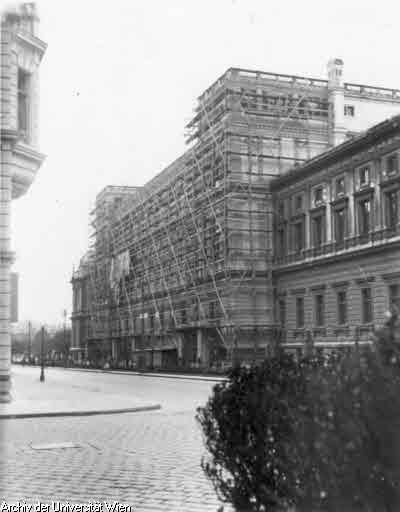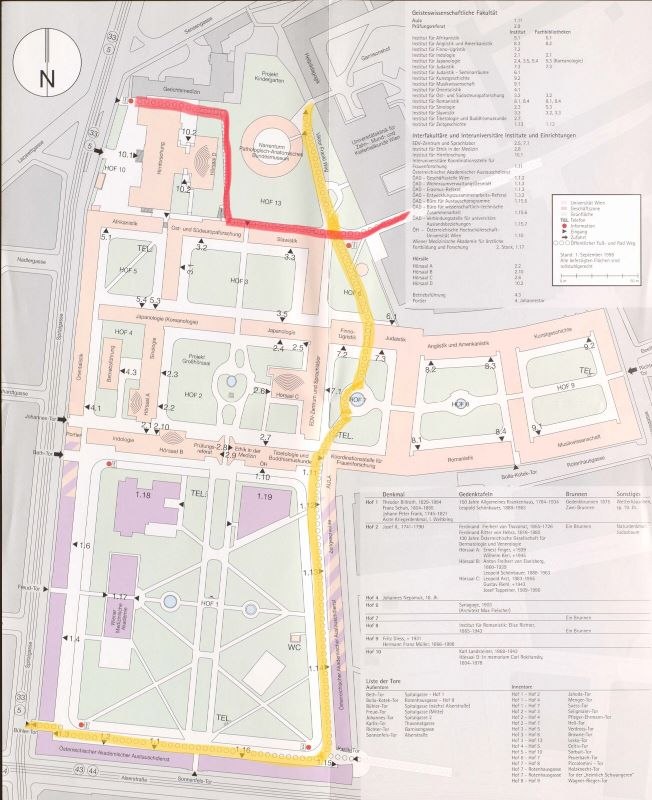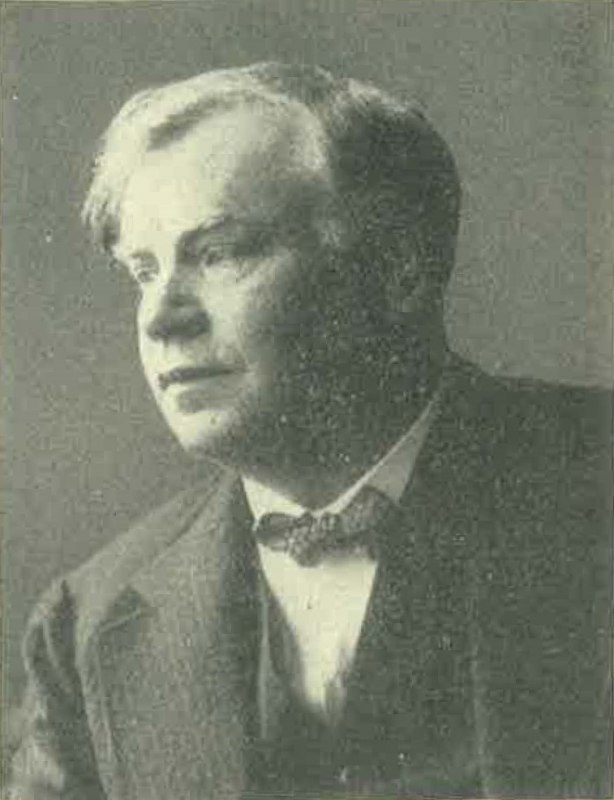Leopold Bauer, Prof.
Architect, designer, writer
Honors
| Ehrung | Titel | Datierung | Fakultät | |
|---|---|---|---|---|
| Badge of Honor | Ehrenz. | 1936 |
Der Vorsitzende der Kunstkommission der Universität Wien, Prof. Gustav Riehl, beantragte 1936 das Ehrenzeichen der Universität Wien an Leopold Bauer als langjährigem Beirat dieser Kommission zu verleihen für seine langjährigen Einsatz, besonders bei der originalgetreuen Renovierung der goldenen Sgrafitti an der Rückseite der Universitätsbibliothek und mit seinen Entwürfe für den Bau eines AudiMax. Am 27. Juni 1936 stimmte der Akademische Senat einstimmig dafür und das Ehrenzeichen wurde ihm am 21. September 1936 von Rektor Oswald Menghin überreicht. In 1936, the Chairman of the Art Commission of the University of Vienna, Prof. Gustav Riehl, requested that Leopold Bauer, as a long-standing member of the commission's advisory board, be awarded the University of Vienna's Decoration of Honor for his many years of service, particularly in the faithful renovation of the golden sgraffiti at the back of the University Library and with his designs for the construction of an AudiMax. On June 27, 1936, the Academic Senate voted unanimously in favour and the medal was presented to him by Rector Oswald Menghin on September 21, 1936. |
|
| Street Name | Leopold-Bauer-Weg | 1998 |
|
Leopold Bauer was born in 1872 in Austrian Silesia as the son of a hotelier, attended secondary school and from 1888-1891 the State School of Applied Arts in Brno [Brünn] and studied architecture from 1892-1896 at the Academy of Fine Arts in Vienna under Carl Hasenauer and Otto Wagner, interrupted by a year of voluntary military service. Together with Olbrich and Hoffmann, he founded the (forerunner of the) Secession during his studies in 1895. From 1897, he was able to take a two-year study trip to Italy, France and Germany on a travel grant.
After returning to Vienna, he married Laura Ficker (1874-1934) in 1900, with whom he had three children: Otto (1900-1991), civil engineer; Harald (1901-1990), architect; Gerda (1903-1950) - the marriage ended in divorce in 1909). He also joined the Vienna Secession in 1900 and began to work independently as an architect.
After an initially radically modern position, he changed his style in a more traditional direction, becoming "marketable" for a more conservative client milieu and economically successful, but at the cost of breaking with previous companions, not least his teacher Otto Wagner.
From 1901, Bauer realized villa buildings in Brno and in his birthplace Jägerndorf as well as designs for furniture, carpets and other furnishings. He was also active in publishing with programmatic considerations and theoretical reflections. In addition to writings such as "Verschiedene Skizzen, Entwürfe und Studien" (1899), he published in the specialist and daily press on architectural theory, urban planning, social and economic issues. He built his own villa in 1906/07 as well as several residential buildings in Vienna and the surrounding area and took part in numerous national tenders (Ministry of War Vienna, Technical Museum Vienna, Museum for Tyrolean Folk Art and Trade Innsbruck, Theater for 5. 000 visitors in Vienna 1, Rudolfsplatz, Vienna Exhibition Center) as well as international tenders (University of California, Berkeley/USA, Peace Palace in The Hague/NL, Administration Building of the Chicago Tribune, Chicago/USA, League of Nations Palace in Geneva/CH, Central Station in Athens/GR, University City Berlin/D, Parliament in Mexico).
From 1910, he was married to Stefanie von Klink (1881-1946), with whom he had four more children: Wolfgang (1911-1995), architect; Bettina (1913-1983); Agnes (1916-1999); Christoph (1920-1945).
From 1913 to 1919, he succeeded Otto Wagner as professor of architecture at the Academy of Fine Arts in Vienna as a compromise candidate, but was rejected by both Wagner's supporters and the students and had to resign his professorship in 1918/19 after an extensive student strike. During this time (1912-1919), however, he created his best-known work today, the Austro-Hungarian Bank, on the site of the Alser Kaserne, which had been demolished for this purpose - although only the printing works building was realized (since 1918 the headquarters of the Austrian National Bank, Vienna 9th, Otto Wagner Platz 3). The huge bank palace and the planned redesign of the entire quarter between Alser Strasse, Spitalgasse, Sensengasse and Währinger Strasse, which was to be freed up by demolishing the General Hospital, Garrison Hospital and Officers' Hospital, were never realized. Today, the campus of the University of Vienna and a large part of the campus of the Medical University of Vienna are located in the remaining listed historical buildings.
After the collapse of the monarchy and the loss of his professorship, Bauer experienced economic difficulties from 1918/19 and devoted himself increasingly to journalism, the planning of industrial buildings, department stores (extension of the Gerngroß department store) and workers' housing in "Red Vienna" (although he was politically opposed to the Social Democrats) and built the Vogelweidhof in Vienna 15. (Hütteldorfer Straße 2a / Wurzbachgasse 2-8 / Sorbaitgasse 3), and the Paul-Speiser-Hof in Vienna 21 (Franklinstraße 20 / Freytaggasse 1-9 and 2-14, 3rd section) from 1929-1932.
Politically, he stood as a candidate in Vienna for the bourgeois-democratic Labor Party and was initially rather opposed to National Socialism, but after the Anschluss in March 1938 he applied for membership of the NSDAP and tried to ingratiate himself as a long-serving National Socialist. However, he died at the age of 66 in Vienna in October 1938 before his NSDAP membership application could be processed.
Memberships
In addition to being a member of the Secession (from its foundation until its dissolution 1900-1938), he was also a member of the Society of Austrian Architects (from 1906), the Central Association of Austrian Architects (from 1907), the Austrian Association of Engineers and Architects (from 1909) and the Vienna Bauhütte (from 1915).
Honors - University of Vienna 1936 and 1998
He had received several awards, including the Golden Medal at the 1904 World's Fair in St. Louis/USA, the Golden Medal of the City of Leipzig in 1913 (on the occasion of the Building Exhibition), in 1915 he was appointed Chief Building Officer and from 1921 became a member of the Board of Directors of several public limited companies such as Dianabad-A.G., Austro-Belgische Eisenbahn-A.G., "Ghaza" Zigarettenhülsen- und Papierfabrik A.G. and Allgemeine Bau-A.G., Leoben, and he was also president of the Austrian Society for Urban Planning.
Under Austrofascism, the chairman of the Art Committee of the University of Vienna, the physician Prof. Gustav Riehl Sr, suggested in June 1936 that the University of Vienna's Medal of Honor be awarded to Leopold Bauer and his two colleagues, all active or former professors at the Academy of Fine Arts, who had been art advisors at the University of Vienna for many years. Leopold Bauer not so much for his design of the city quarter after the planned demolition of the university clinics and the old AKH, but rather for his achievement in the faithful renovation of the unrecognizable golden sgraffiti by Ferstl on the back of the university library in 1929 and also for his designs for the construction of an AudiMax, which was then built in 1936 by using court VI, and for his advisory work on the monuments in the arcaded courtyard, where he also designed the plinth for the bust of the lawyer Franz Klein in 1936/37.). Josef Müllner, the sculptor of the "Siegfriedskopf" war memorial (1916, erected in the Aula in 1923) and the Karl Lueger memorial (1916, unveiled in 1926), and Rudolf Bacher, who designed the newly invented gowns for the dignitaries of the University of Vienna in 1927/28, when this official costume was introduced in 1928, were also honored. On June 27, 1936, the Senate voted unanimously to award the three of them the medal of honor mounted on a red-white-red ribbon. Leopold Bauer was only presented with it by Rector Oswald Menghin on September 21, 1936 due to scheduling reasons.
Leopold Bauer was also honored when the path for the east-west-route of the area was named "Leopold-Bauer-Weg" after him during the conversion of the Old General Hospital into the campus of the University of Vienna (1992-1998): It leads from Währinger Straße, past the new banknote printing building and the old "Narrenturm", down a staircase into courtyard 10 and there into Spitalgasse 4 (at the "Marpe Lanefesch" monument in courtyard 6, it crosses the "Viktor-E.-Frankl-Weg", which represents the north-south-route). In the course of opening up and developing the area, the university assigned these two street names when the campus was opened in 1998; they are located on the private property of the University of Vienna and therefore do not appear in the Vienna street map. Whether the reason was more to honor the architect of the old Nationalbank printing building near the new banknote printing building or rather in memory of the fact that his concept for the total demolition of the entire quarter was not implemented must remain speculation, as the reason for the naming does not emerge from the archival holdings.
Writings
His writings include
- Verschiedene Skizzen, Entwürfe und Studien (Various sketches, drafts and studies) (Vienna, 1899)
- Neubauten der Österreichisch-ungarischen Bank in Wien (New buildings of the Austro-Hungarian Bank in Vienna) (Vienna, 1913)
- Gesund wohnen und freudig arbeiten: Probleme unserer Zeit (Healthy living and happy working: Problems of our time) (Vienna, 1919)
- Oberbaurat Professor Leopold Bauer : seine Anschauung in Wort und Werk. Vienna/Leipzig 1931 (= Series of Viennese Architects)
His estate is in the Albertina, Vienna, and a partial estate is in the archive of the Academy of Fine Arts Vienna
Weblinks
> Vienna History Wiki
> Wikipedia: Leopold Bauer (architect)
> Austrian Biographical Dictionary: Leopold Bauer
> Architekturzentrum Wien: Architektenlexikon: Lepold Bauer
Archive of the University of Vienna, R 34.4: Book of Honor 1921-1959, Senate S 91.8
Zuletzt aktualisiert am 04/25/24
-

Austrian National Bank
Built by architect Leopold Bauer as the printing building of the Austro-Hungarian Bank 1914-1918, after the collaps of the Austro-Hungarian Monarchy...
-

Urban planning study by Leopold Bauer in 1918, after the planned demolition of AAKH, Garrison Hospital No. 1 and Officers' Hospital
Urban planning study by Leopold Bauer in 1918 for the 9th district, on the site that was to be created after the demolition of the old General...
-

Renovation of the sgraffiti on the back of the university (library) 1929
1929 Renovation of the rear wall of the university (library) with the sgraffiti (important decorative element of architect Heinrich von Ferstl),...
-

Proof of certificate of honor for Leopold Bauer, 1936
-

Street signs on the campus of the University of Vienna: Viktor E. Frankl Weg / Leopold Bauer Weg
-

Campus-Map from the opening in 1998, routes marked
Campus opening map from 1998, the color-coded routing of Viktor E.-Frankl-Weg (N-S) and Leopold-Bauer-Werg (E-W) When the University of Vienna campus...

